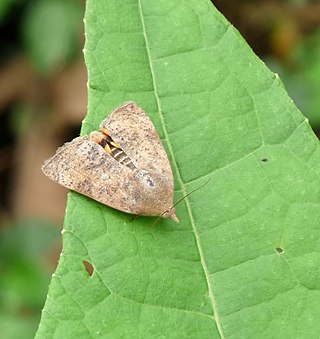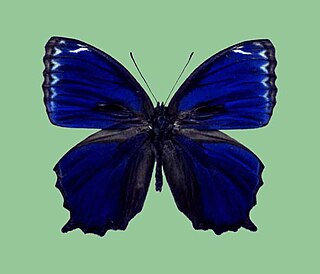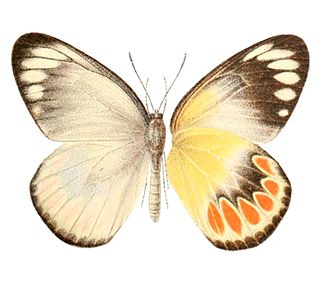
Caterpillars are the larval stage of members of the order Lepidoptera.

The Nymphalidae are the largest family of butterflies, with more than 6,000 species distributed throughout most of the world. Belonging to the superfamily Papilionoidea, they are usually medium-sized to large butterflies. Most species have a reduced pair of forelegs and many hold their colourful wings flat when resting. They are also called brush-footed butterflies or four-footed butterflies, because they are known to stand on only four legs while the other two are curled up; in some species, these forelegs have a brush-like set of hairs, which gives this family its other common name. Many species are brightly coloured and include popular species such as the emperors, monarch butterfly, admirals, tortoiseshells, and fritillaries. However, the under wings are, in contrast, often dull and in some species look remarkably like dead leaves, or are much paler, producing a cryptic effect that helps the butterflies blend into their surroundings.

An eyebrow is an area of short hairs above each eye that follows the shape of the lower margin of the brow ridges of some mammals. In humans, eyebrows serve two main functions: first, communication through facial expression, and second, prevention of sweat, water, and other debris from falling down into the eye socket. It is common for people to modify their eyebrows by means of hair removal and makeup.

The large tortoiseshell or blackleg tortoiseshell is a butterfly of the family Nymphalidae.

The queen butterfly is a North and South American butterfly in the family Nymphalidae with a wingspan of 80–85 mm. It is orange or brown with black wing borders and small white forewing spots on its dorsal wing surface, and reddish ventral wing surface fairly similar to the dorsal surface. The ventral hindwings have black veins and small white spots in a black border. The male has a black androconial scent patch on its dorsal hindwings. It can be found in meadows, fields, marshes, deserts, and at the edges of forests.

Eumaeus atala, also known as the Atala butterfly or coontie hairstreak, is a small colorful butterfly in the family Lycaenidae. It is found in southeastern Florida in the United States, Cuba, the Bahamas, and the Cayman Islands in the West Indies. Its coloration and habits are unique among butterflies within its range.

Hyblaeidae are the "teak moths", a family of insects in the Lepidopteran order. The two genera with about 18 species make up one of the two families of the Hyblaeoidea superfamily, which in the past has been included in the Pyraloidea. Recent phylogenetic studies find varying relationships of Hyblaeoidea among Ditrysian Lepidoptera: Mutanen et al. (2010) find the superfamily to group either with Pyraloidea, or – more often – with Thyridoidea or butterflies. The results of Wahlberg et al. (2013) and Heikilä et al. (2015) indicate a sister-group relationship with Pyraloidea.

Ornithoptera paradisea, the paradise birdwing, is a species of birdwing butterfly found in New Guinea.
Lygniodes is a genus of moths in the family Erebidae first described by Achille Guenée in 1852. The genus is restricted to the Asiatic tropics, east to Sulawesi and the Moluccas.

Saletara liberia is a butterfly of the family Pieridae. It is found in Indonesia, the Philippines, Peninsular Malaysia and various islands in the region. Subspecies S. l. distanti is known by the common name Malaysian albatross.

Hair-pencils and coremata are pheromone signaling structures present in lepidopteran males. Males use hair-pencils in courtship behaviors with females. The pheromones they excrete serve as both aphrodisiacs and tranquilizers to females as well as repellents to conspecific males. Hair-pencil glands are stored inside the male until courtship begins, at which point they are forced out of the body by sclerotized levers present on the abdomen. Coremata are very similar structures. Their exact definition is confused by early descriptions but they are more specifically defined as the internal, glandular, eversible structures that bear the hair-pencils and can be voluntarily inflated with hemolymph or air.

Ptychandra ohtanii is a butterfly of the family Nymphalidae. It is endemic to the Philippines. Its forewing length is 26–29 mm. The species resembles P. lorquinii. Black hair-pencil is arising in space 3 of forewing upperside in P. ohtanii whereas arising on cubitus in P. lorquinii. The nominotypical subspecies is distributed only on Mount Apo on Mindanao island. Another subspecies is found on Leyte island. The species is rare on both islands.

Bicyclus aurivillii is a butterfly in the family Nymphalidae. It is found in the Democratic Republic of the Congo, Uganda, Rwanda and Burundi.

Amathusia is a genus of large forest butterflies with "wingtails" in the family Nymphalidae. They are known as the palmkings and the larvae feed on palms (Arecaceae). Amathusia ranges from the Andaman Islands to Sulawesi.

Taenaris schoenbergi is a species of butterfly in the family Nymphalidae. It is endemic to New Guinea.

Delias schoenbergi is a butterfly in the family Pieridae. It was described by Walter Rothschild in 1895. It is found in the Australasian realm.

Amathusia perakana, the perak palmking, is a butterfly found in Peninsular Malaya, Sumatra, Borneo and the Natuna Islands. It belongs to the Satyrinae, a subfamily of the brush-footed butterflies.
Amathusia binghami is a butterfly found in Peninsular Malaya and Sumatra It belongs to the Satyrinae, a subfamily of the brush-footed butterflies.
Amathusia friderici, commonly known as bicolor-haired palmking, is a butterfly found in the Indomalayan realm It belongs to the Satyrinae, a subfamily of the brush-footed butterflies.

Amathusia ochraceofusca , the pale-haired palmking, is a butterfly found in the Indomalayan realm It belongs to the Satyrinae, a subfamily of the brush-footed butterflies.
















